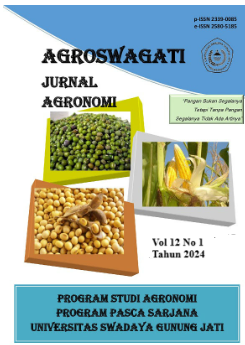PENGARUH ZAT PENGATUR TUMBUH GIBERELIN DAN PUPUK KOMPOS TERHADAP PERTUMBUHAN DAN HASIL TANAMAN KACANG HIJAU (Vigna radiata L) VARIETAS VIMA 4
DOI:
https://doi.org/10.33603/agroswagati.v12i1.10871Abstract
This study aimed to determine the interaction effects of gibberellin concentrations and compost application on the growth and yield of the mung bean (Vigna radiata L.) variety Vima 4. The experiment was conducted from August to October 2021 at the Agricultural Complex of the Ma'had Al-Zaytun Campus, Mekarjaya Village, Gantar District, Indramayu Regency, West Java Province. The site is situated approximately 50 m above sea level, on Latosol–Regosol soils, under a Type D rainfall pattern. The research employed a factorial randomized block design (RBD) with three replications. The first factor was gibberellin concentration (5 ppm/plant, 10 ppm/plant, and 15 ppm/plant), while the second factor was compost dosage (10 tons/ha, 15 tons/ha, and 20 tons/ha). Data were analyzed using analysis of variance (ANOVA), followed by Duncan’s multiple range test, and correlation analysis was conducted using the product-moment correlation coefficient. Results showed that there was a significant interaction between gibberellin concentration and compost application on plant height and leaf area index (LAI). The treatment combination of 10 ppm gibberellin with 15 tons/ha compost yielded 0.67 kg of seeds per plot, which was not significantly different from other treatments. A significant positive correlation was observed between plant height and number of leaves at 35 days after planting (DAP) and between plant growth at 21 DAP with seed yield per plot. The correlation between plant growth traits and yield was categorized as moderate.
Downloads
Published
Issue
Section
Citation Check
License
Copyright (c) 2025 Yusup Yusup, Endang Tadjudin, Ali Efendi

This work is licensed under a Creative Commons Attribution-ShareAlike 4.0 International License.
The Authors submitting a manuscript do so on the understanding that if accepted for publication, copyright of the article shall be assigned to Jurnal AGROSWAGATI, Sekolah Pascasarjana Ilmu Pertanian. Universitas Swadaya Gunung Jati as publisher of the journal. Copyright encompasses rights to reproduce and deliver the article in all form and media, including reprints, photographs, microfilms, and any other similar reproductions, as well as translations.
Jurnal AGROSWAGATI, Universitas Swadaya Gunung Jati and the Editors make every effort to ensure that no wrong or misleading data, opinions or statements be published in the journal. In any way, the contents of the articles and advertisements published in Jurnal AGROSWAGATIare the sole responsibility of their respective authors and advertisers.










